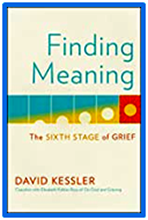Doula Pages — End of Life DOULA — Doula Resources — Community Education — Life Limiting Diagnosis — Companion Support — Grieving — Something to Ponder — Seasons Death Café — Talking Circle
Grieving maybe one of the most painful emotion human beings experience.
 In David Kessler 's book FINDING MEANING, The Sixth Stage of Grief, he shares an important understanding in managing our grief. Kessler suggests that when one has fully felt the pain of grief it may be time to move into love—to balance the pain of out grief with memories of our love.
In David Kessler 's book FINDING MEANING, The Sixth Stage of Grief, he shares an important understanding in managing our grief. Kessler suggests that when one has fully felt the pain of grief it may be time to move into love—to balance the pain of out grief with memories of our love.
Kessler shares [page 198-200] :
Psychologist Rick Hanson says, "The brain is very good at learning from bad experiences, yet very, very bad are learning from good experiences. Neuroprocessing is privileged for negative stimuli. When a bad thing happens, we give more attention to the negative." He describes our minds as Velcro for the bad experiences (everything sticks), and Teflon for the good (nothing sticks).
We are wired to not smell the roses. Negative moments, which are held in both short-term and long-term memory, become deeply wired and burned into our psyche. The same is not true for the positive ones, which are less likely to make it into the long-term memory bank. This is why you might quickly forget many of the wonderful moments with your loved one, but the negative ones will live on in endless repetition.
It's thought that our minds are wired this way because of the survival benefits it offers: Survival requires urgent attention to possible bad outcomes but less urgent [attention] with regard to good news," according Roy F. Baumeister, a professor of social psychology at Florida State University who wrote about his in a journal article he coauthored, "Bad Is Stronger Than Good," which appears in the Review of General Psychology.
Since our minds are wired for the negative, how do we find love through all the pain? Rick Hanson teaches a technique that has been widely used called "Installing the good" or sometimes "Taking in the good." It helps us to find ways to give more attention to the good. I use the following technique to help people remember all the moments of their lives with their loved ones who died.
THE THREE STEPS OF TAKIN IN THE GOOD
- Identify a positive experience or memory—how good your coffee tasted this morning.
You can do this with a positive experience, from the most ordinary to the most meaningful. In terms of the person who died, think about a wonderful moment you shared. It doesn't have to be anything extraordinary, just something that made you both happy. Maybe you watched a sunset together, read a poem to each other, took a two-hour walk through a city you loved.
As Emily in the play Our Town was advised, when you she was given the chance to return to earth for any day of her choosing, "Pick the least important day in your life. It will be important enough." Remember it in as much detail as you like, what you said to each other, any sound or smells, or sensations associated with it. - Enrich it. Savor it. Think about it. Repeat it over and over in your mind. Sustain the memory of the good time for twenty or thirty seconds. Recapture the feelings of it in your body and emotions. Intensify it.
- Absorb the experience. Sink into it and let it sink into you. Soak it in. feel it in your body, visualize it in your mind, let it become part of you.
Learning to live with loss is like any other kind of learning. And learning to find the good even as we are in pain is a particular difficult kind of learning. This technique can help integrate the good with the pain. I want grieving people to see the relevance in all that has happened. There is pain in their loss, but there is also good.
I want them to savor the love, not just stay with the pain. I want to help them find meaning in their memories and take that good into the future. If you only see the pain in a situation, it will grow. I'm not suggesting we minimize or negate it, but if that's all you pay attention to, that's all you'll have.
In 1969, Elisabeth Kübler-Ross first identified the stages of dying in her transformative book On Death and Dying. Decades later, she and David Kessler wrote the classic On Grief and Grieving, introducing the stages of grief with the same transformative pragmatism and compassion. Now, based on hard-earned personal experiences, as well as knowledge and wisdom gained through decades of work with the grieving, Kessler introduces a critical sixth stage: meaning.
